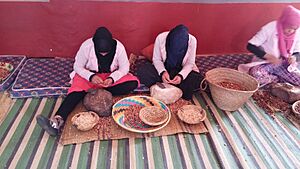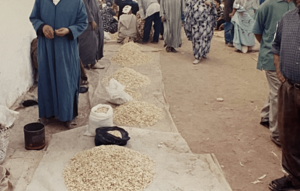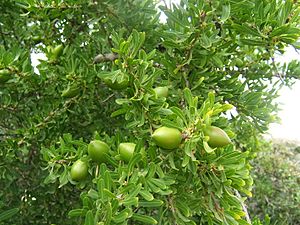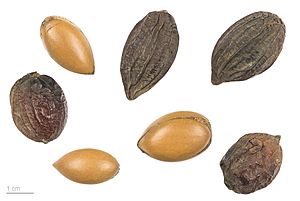Argania facts for kids
Quick facts for kids Argania |
|
|---|---|
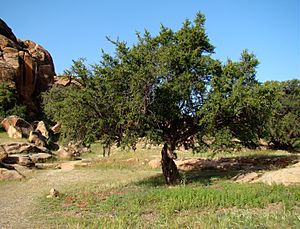 |
|
| Scientific classification | |
| Genus: |
Argania
|
| Species: |
spinosa
|
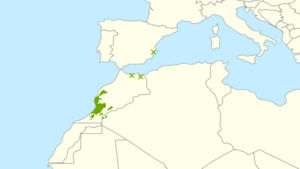 |
|
| Native range of A. spinosa | |
| Synonyms | |
|
|
| Argan, practices and know-how concerning the argan tree | |
|---|---|
|
UNESCO Intangible Cultural Heritage
|
|

Argan paste making
|
|
| Country | Morocco |
| Reference | 955 |
| Inscription history | |
| Inscription | 2014 (14nd session) |
| List | Representative |
 |
|
The Argania spinosa, often just called argan, is a special tree. It is the only type of tree in its group, called Argania. These trees are found only in a few places. They grow in the dry, rocky areas of southwestern Morocco. You can also find them in the Tindouf region of southwestern Algeria.
Argan trees can grow quite tall, usually about 8 to 10 meters (26 to 33 feet) high. They can live for a very long time, up to 200 years! These trees have thorny branches and twisted trunks. Their wide tops can spread out about 70 meters (230 feet) around. The branches often bend down towards the ground.
The leaves of the argan tree are small, about 2 to 4 centimeters (1 to 1.5 inches) long. They are oval-shaped with a rounded tip. The tree's flowers are tiny and have five pale yellow-green petals. They bloom in April. The fruit is about 2 to 4 centimeters (1 to 1.5 inches) long. It has a thick, bitter skin. Inside, there is a sweet-smelling but not tasty pulp. This pulp surrounds a very hard nut. Inside the nut, there are one to three small seeds. These seeds are rich in oil. The fruit takes over a year to ripen, usually ready in June or July of the next year.
Contents
What's in a Name? The Argan Tree's Story
The scientific name Argania comes from the word argan. This is what the tree is called in the Shilha language. Shilha is a Berber language spoken by most people where the argan tree grows. The people who speak Shilha have many words for the different parts of the fruit. They also have words for how ripe it is and how it is gathered. The oil from the tree is also called argan.
International Argania Day: A Global Celebration
On March 3, 2021, the United Nations decided something important. They announced that May 10th would be the International Day of Argania. This day is now celebrated every year. The UN chose this day because the argan tree is very important. It helps with sustainable development in the areas where it grows. Morocco suggested this special day. Many other countries, 113 in total, supported the idea. Everyone agreed to make it an official day.
Where Argan Trees Grow and How They Are Used
In Morocco, the forests of argan trees are called arganeraie. These forests now cover about 8,280 square kilometers (3,200 square miles). The UNESCO has named them a special biosphere reserve. This means they are protected. Sadly, these forests have shrunk by about half in the last 100 years. This happened because people cut trees for charcoal. They also let too many animals graze. And they used more land for farming.
There is hope for saving these trees. People have started selling argan oil around the world. This oil is very valuable. However, this new wealth has also brought problems. Locals can now afford to buy more goats. These goats climb the argan trees and eat their leaves and fruit. This stops the trees from growing well. Sometimes, for tourists, goats are even made to climb the trees. This is because goats do not often climb trees on their own.
Argan trees are also grown in the Arabah and Negev areas of Israel.
How Argan Trees Help People and Animals
In some parts of Morocco, argan trees are very important. They are used like olive trees. They provide food for animals, oil, wood, and fuel. In Berber communities, the argan tree is a key resource.
Near Essaouira, goats often climb the argan trees.
Argan Fruit: A Special Harvest
Argan fruit falls from the trees in July. By then, they are black and dry. Before this, people keep goats away from the argan forests. Rules and village traditions control who can collect the fruit. After goats eat the fruit, they spit out the hard "nuts." This helps spread the argan seeds to new places.
Argan Oil: A Precious Liquid
Argan oil is made by several women's groups in southwestern Morocco. Making the oil is a lot of work. First, the soft pulp is removed from the fruit. This pulp is used to feed animals. Then, the hard nut is cracked open by hand, usually between two stones. The seeds are taken out and gently roasted. This roasting gives the oil its special nutty taste.
The old way to get the oil is to grind the roasted seeds into a paste. A little water is added. This is done using a stone mill. Then, the paste is squeezed by hand to get the oil out. The leftover paste still has some oil. It is used as animal feed. Oil made this way can be kept for 3 to 6 months. People can make oil as they need it. The kernels (seeds) can be stored for 20 years if not opened.
Today, dry-pressing is becoming more common for oil sold in stores. This method is faster. Oil made this way can last for 12 to 18 months.
Argan oil is very healthy. It has 80% unsaturated fatty acids. These are good fats. It also resists going bad better than olive oil. People use argan oil for dipping bread. They also use it on couscous and salads. A special dip for bread is called amlou. It is made from argan oil, almonds, and peanuts. Sometimes, honey or sugar is added to make it sweet.
The oil that is not roasted is used for skin problems. European makeup companies now use it a lot.
Argan oil is sold as a luxury item in Morocco. Its sales have grown a lot since the early 2000s. This is because makeup companies in the US and Europe started selling it. It costs much more than other oils.
Argan for Animal Feed
Argan trees are a main food source for many animals. Sheep, goats, camels, and cattle all eat argan fruits and leaves. The leftover paste from oil extraction can also be dried in the sun. Then, it is fed to these animals. Bees also like to build their nests in argan trees. This makes them good places for collecting wild honey.
See also
 In Spanish: Argania spinosa para niños
In Spanish: Argania spinosa para niños



